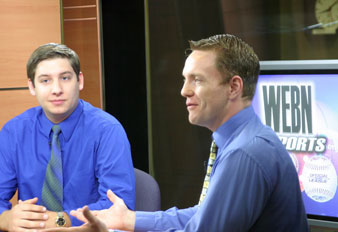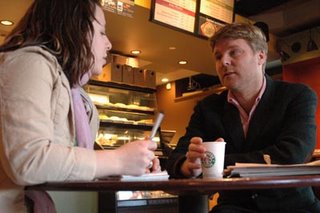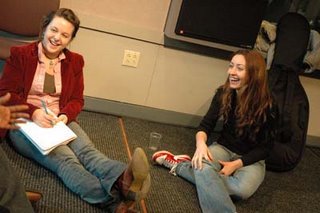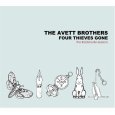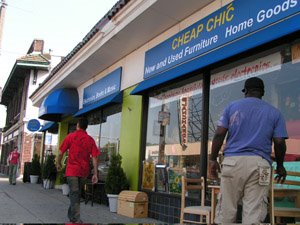
(painting courtesy of www.lehigh.edu; N. Scott Momaday, "Admiral of the Ocean Seas")
Published April 6, 2006
Correct me if I am wrong, but after reading Mr. Momaday's book twice, writing a paper on him, attending his lecture, and speaking with him during a press interview and two luncheons, I would hope that I can say with some instinctual knowledge that Momaday's painting here captures his essence much better than any photographs of the man. Here you see an older, imposing figure in dark, bold relief, in a hat very characteristic to Momaday. He is leaning over a figure to whom he might be telling a story, which is his favorite thing--the more listeners, the better.
You might imagine a man with a wide, gracious brow; a string tie worn proudly, never ironically; a well-fitted suit in dark colors; and with him he carries an elegant cane, which he leans his chin on when he is making a particular point. His elocution hints at speech coaching and a serious thespian bent, while his stories of his own college age are filled with tales of Stanford and reading the manuscripts of Emily Dickinson during cold New England winters.
Momaday's mother was a writer and his father was a painter, and both influences figure prominently in "The Way to Rainy Mountain," his 70s swan song to the Kiowa tribe of which he is a part. Momaday began as a writer, but as a Pulitzer Prize-winner he has now been all over the world, on many seas, talking to people on many different continents, and he has found new life in painting what he knows. He believes fondly in the intrinsic talent for art in his native American students, but he came to Emerson to encourage the storytellers among us.
Momaday is somewhat of a disappointment to me. I am from the West, where people have little pretension, less starch in their clothing, a slower and less calculated way of talking. Momaday is a slick and nearly patronizing man who strikes an imposing if not entirely un-grandfatherly figure, and he does not immediately put me at ease. I am filled with a homesickness for the West he writes about which does not find its resolution in meeting him: he is too much like the Easterner I have become. But on that level we begin to relate, and he ends up charming me in the end, with a story that did not make it to print:
Once, Mr. Momaday was asked to write a chapter for a written history on the United States, and to represent "the Native American voice." He began, ill at ease with the concept, and said with understated irony, "You see, I was taught in school that 'our' history began in New England in the 1600s." So he fell into the writerly exercise of looking his task up in the dictionary. "Under 'to write,' it read 'to incise upon a surface,'" Momaday said. I waited with my pen for the punchline. "And this opened the floodgates, as I could then argue that the written history of the United States began in Utah with the petroglyphs, two thousand years ago!" he finished triumphantly.
All in all, I think I gave Momaday a fair treatment in this article. I could never shed my idea of him as a too-polished cane, holding up a limping social movement, but I could respect the fact that he felt obligated to do so, and did it as well as it could be done.
Here's the lead paragraph for the story:
Author N. Scott Momaday joined the ranks of Whoopi Goldberg, Edward Albee and Anna Deveare-Smith as a visiting artist-in-residence at Emerson this weekend, speaking about his favorite subjects: identity, words, the oral tradition, the state of Native Americans and indigenous people worldwide and killing icebergs...
